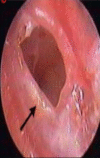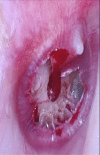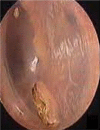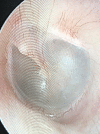Factors Influencing the Outcome of Spontaneous Healing of Traumatic Tympanic Membrane Perforation: A Clinical Prospective Observational Study
- PMID: 37636775
- PMCID: PMC10447838
- DOI: 10.1007/s12070-023-03722-4
Factors Influencing the Outcome of Spontaneous Healing of Traumatic Tympanic Membrane Perforation: A Clinical Prospective Observational Study
Abstract
Trauma to the ear is typically attributed to its location in the craniofacial skeleton. TM is prone to rupture, tear, or perforation when traumatized. Etiological factors may be classified according to the pathogenetic mechanisms (air-pressure change, heat, solids, water pressure).
Materials & method: This is a prospective study of 70 patients with traumatic tympanic membrane perforation between January 2019 and December 2022. Inclusion and exclusion criteria applied and results interpreted.
Results: Traumatic TM affects all age groups with a mean age of 27.94 ± 4.76 years. Traumatic TM affects all age groups with a mean age of 27.94 ± 4.76 years, with the highest incidence among the middle-aged groups 61.4%. The male-to-female ratio was found to be 1.9:1, with high predominance among male patients (65.7%) with a frequency of 57.1% for slap injury group in our study contrary to others. Spontaneous healing was observed in 88.6% over a follow-up period of 12 weeks in this study. Our study has not shown that associated comorbidities influence healing (P = 0.550). About 45.5% Marginal perforations have not healed in 12 weeks follow-up period as compared to central perforations 5.1%.
Conclusion: There is a high predominance of TM perforation among male patients in our study may be attributed to activity. Spontaneous healing is more common. Duration of healing was significantly affected by the size of the perforation with longer duration for large perforations and vice versa. It is observed in this study that the duration of spontaneous healing is longer in blast injuries when compared to other kinds of injuries. A significant proportion of marginal perforations that have not healed in our study may be attributed to annular ligament involvement.
Keywords: Bleeding ear; Eardrum; Hearing loss; Myingolysis; Rupture; Trauma; Tympanic membrane perforation.
© Association of Otolaryngologists of India 2023. Springer Nature or its licensor (e.g. a society or other partner) holds exclusive rights to this article under a publishing agreement with the author(s) or other rightsholder(s); author self-archiving of the accepted manuscript version of this article is solely governed by the terms of such publishing agreement and applicable law.
Figures






Similar articles
-
Determinants of spontaneous healing in traumatic perforations of the tympanic membrane.Clin Otolaryngol. 2008 Oct;33(5):420-6. doi: 10.1111/j.1749-4486.2008.01764.x. Clin Otolaryngol. 2008. PMID: 18983374
-
Traumatic tympanic membrane perforations: a study of etiology and factors affecting outcome.Am J Otolaryngol. 2012 Sep-Oct;33(5):549-55. doi: 10.1016/j.amjoto.2012.01.010. Epub 2012 Feb 22. Am J Otolaryngol. 2012. PMID: 22365389
-
Non-explosive blast injury of the tympanic membrane in Umuahia, Nigeria.Niger J Med. 2009 Oct-Dec;18(4):365-9. doi: 10.4314/njm.v18i4.51227. Niger J Med. 2009. PMID: 20120138
-
The Effect of Using Ofloxacin Ear Drops in Traumatic Tympanic Membrane Healing: A Systematic Review and Meta-Analysis.Ear Nose Throat J. 2024 Jun 22:1455613241264479. doi: 10.1177/01455613241264479. Online ahead of print. Ear Nose Throat J. 2024. PMID: 38907707 Review.
-
Spontaneous healing of traumatic tympanic membrane perforations in man: a century of experience.J Laryngol Otol. 1992 Dec;106(12):1037-50. doi: 10.1017/s0022215100121723. J Laryngol Otol. 1992. PMID: 1487657 Review.
Cited by
-
Traumatic Tympanic Membrane Perforation in Children: A Descriptive Cross-sectional Study.JNMA J Nepal Med Assoc. 2024 Jun 30;62(275):463-467. doi: 10.31729/jnma.8652. JNMA J Nepal Med Assoc. 2024. PMID: 39369415 Free PMC article.
References
LinkOut - more resources
Full Text Sources
Research Materials
